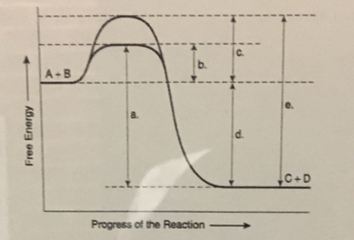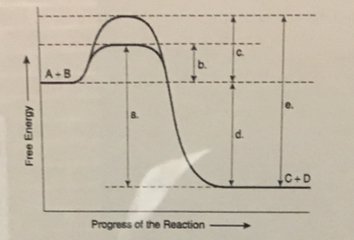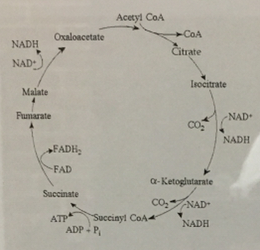Which of the following describes cell communication systems?
A. Most signal receptors are bound to the outer membrane of the nuclear envelope.
B. Communicating cells are usually close together.
C. In response to a signal, the cell may alter activities by changes in enzyme activities or in gene expression
D. Lipid phosphorylation is a major mechanism of signal transductions
Answer C
Phosphorylation cascades involving a series of protein kinases are useful for cellular signal transduction because
A. they are species specific.
B. they always lead to the same cellular response
C. they amplify the original signal many fold.
D. the number of molecules used is small and fixed
E. they counter the harmful effects go phosphatases
Answer C
Consider this pathway: epinephrine > G protein-coupled receptor > G protein > adenylyl cyclase > cAMP. Identify the second messanger.
A. GTP
B. G protein-coupled receptor
C. cAMP
D. adenylyl cyclase
E. G protein
Answer C
A drug that inhibits activity of which of the following could be used to block the release of calcium ion from the endoplasmic reticulum?
A. tyrosine kinases
B. adenylyl cyclase that produces cAMP
C.phosphodiesterase
D. serine/threonine kinases
E. phospholipase C that produces IP3
Answer E
Which of the following is a correct association?
A. adenylyl cyclase activity and conversion of cAMP to AMP
B. phosphodiesterase activity and the removal of phosphate groups
C. GTPase activity and hydrolysis of HTP to GDP
D. kinase activity and the addition of a tyrosine
Answer C
Which term most precisely describes the cellular process of breaking down large molecules into smaller ones?
A. dehydration
B. catalysis
C. anabolism
D. metabolism
E. catabolism
Answer E
Which of the following is (are) true for anabolic pathways?
A. they release energy as they degrade polymers to monomers
B. They do not depend on enzymes
C. They are usually highly spontaneous chemical reactions
D. They consume energy to build up polymers from monomers
Answer D
8. Which.........exergonic reactions
A. Some reactants will be converted to products
B. a net input of energy from the surroundings is required for the reactions to proceed.
C. The reactions are non-spontaneous
D. The reaction proceeds with a net release of free energy
E. The priciest have more total energy than the reactants
Answer D
A chemical reaction that has a positive ^G is correctly described as
A. endothermic
B. exothermic
C. spontaneous
D. endergonic
E. enthalpic
Answer D
Which of the following statements is (are) true about enzyme-catalyzed reactions?
A. the free energy of the reaction is opposite form the reaction in the absence of the enzyme
B. The reaction always goes in the direction toward chemical equilibrium
C. The reaction is faster than the same reaction in the absence of the enzyme
D. A and B only
Answer C
Reactants capable of interacting to form precepts in a chemical reaction must first overcome a thermodynamic barrier known as the reaction's
A. activation energy
B. fee-energy content
C. endothermic level
D.heat content
E. entropy
Answer A
A solution of starch at room temperature does not readily decompose to form a solution of simple sugars because
A. starch cannot be hydrolyzed in the presence of so much water
B. the hydrolysis of starch to sugar is endergonic
C. the starch solution has less free energy than the sugar solution
D. the activation energy barrier for this reaction cannot be surmounted
Answer D
The active site of an enzyme is the region that
A. binds the products of the catalytic reaction.
B. binds allosteric regulators of the enzyme
C. is inhibited by the presence of a coenzyme of a cofactor
D. binds to the substrate and is involved in the catalytic reaction of the enzyme
Answer D
During a laboratory experiment, you discover that an enzyme-catalyzed reaction has a ^G of -20 kcal/mol. If you double the amount of enzyme in the reaction, what will be the ^G for the reaction?
A. ....
B. +20 kcal.mol
C. -20 kcal/mol
D. -40 kcal/mol
E. +40 kcal/mol
Answer C
Zinc, an essential trace element for most organisms, is present in the active site of the enzyme carboxypeptidase. The sin most likely functions as a(n)
A. noncompetitive inhibitor of the enzyme
B. activator of the enzyme
C. competitive inhibitor of the enzyme
D. cofactor necessary for enzyme activity
E. coenzyme derived from a vitamin
Answer D
Succinate dehydrogenase catalyzes the conversion of succinate to fumarate. The reaction is inhibited by malonic acid, which resembles succinate but cannot be acted upon by succcinate dehydrogenase. Which one of the following statements correctly describes the action of malonic acid?
A. it is able to bind to succinate.
B. It is a competitive inhibitor
C. It blocks the binding of fumarate
D. It is a noncompetitive inhibitor
E. It replaces the usually enzyme
Answer B

Which of the following represents the ^G of the reaction?
A. a
B. b
C. c
D. d
E. e
Answer D

Which of the following represents the activation energy required for the enzyme-catalyzed reaction?
A. a
B. b
C. c
D. d
E. e
Answer B
The molecule that functions as the reducing agent (electron donor) in a redox reaction or oxidation-reduction reaction
A. gains electrons and gains energy
B. loses electrons and gains energy
C. gains electrons and loses energy
D. neither gains nor loses electrons, but gains or else energy
E. loses electrons and loses energy
Answer E
Where does glycolysis take place?
A. mitochondrial inner membrane
B. mitochondrial intermembrane space
C. mitochondrial outer membrane
D. mitochondrial matrix
E. cytosol
Answer E
The ATP made during glycolysis is generated by
A. electron transport
B. oxidation of NADH to NAD+
C. substrate-level phosphorylation
D. photophosphoylation
E. chemiosmosis
Answer C
The oxygen consumed during cellular respiration is involved directly in which process of event?
A. accepting electrons at the end of the electron transport chain
B. the citric acid cycle
C. the phosphorylation of ADP to form ATP
D. the oxidation of pyruvate to acetyl CoA
E. glycolysis
Answer A
Which of the following statements describes NAD+?
A. NAD+ is reduced to NADH during both glycolysis and the citric acid cycle
B. ....
C. NAD+ is reduced by the action of hydrogenases
D. NAD+ has ore chemical energy than NADH
E. in the absence of NAD+, glycolysis can still function
Answer A
In addition to ATP, what are the end products of glycolysis?
A. CO2 and pyruvate
B. H2O, FADH2, and citrate
C. CO2 and NADH
D. NADH and pyruvate
E. CO2 and H2O
Answer D
Which of the following intermediary metabolites enters the citric acid cycle and is formed, in part, by the removal of a carbon (CO2) from one molecule of pyruvate?
A. lactate
B. oxaloacetate
C. citrate
D. glyceraldehydes-3-phosphate
E. acetyl CoA
Answer E
In glycolysis, for each molecule of glucose oxidized to pyruvate
A. 6 molecules of ATP are used and 6 molecules of ATP are produced
B. 2 molecules of ATP are used and 6 molecules of ATP are produced
C. 2 molecules of ATP are used and 2 molecules of ATP are produced
D. 4 molecules of ATP are used and 2 molecules of ATP are produced
E. 2 molecules of ATP are used and 4 molecules of ATP are produced
Answer E
In oxidative phosphorylation, what is the most direct source of energy that is used to convert ADP + Pi to ATP?
A. energy released form substrate-level phosphorylation
B. No external source of energy is required because the reaction is exergonic.
C. energy released form movement of protons through ATP synthase
D. energy released from ATP synthase pumping hydrogen ions from the mitochondrial matrix
E. energy released as electrons flow through the electron transport system
Answer C
Which of the following is common to both cellular respiration and fermentation?
A. oxidative phosphorylation
B. chemiosmosis
C. the citric acid cycle
D. the oxidation of pyruvate to acetyl CoA
E. glycolysis
Answer E
29. ...... electron transport chain in mitochondria?
A. NAD+, FAD, and electrons
B. NADH, FADH2, and protons
C. NADH and FADH2
D. oxygen, carbon dioxide, and water
E. Oxygen and electrons
Answer C
The direct energy source that drives ATP synthesis during oxidative phosphorylation is
A. the thermodynamically favorable flow of electrons from NADH to the mitochondrial electron transport carriers
B. the difference in H+ concentrations on opposite sides of the inner mitochondrial membrane
C. oxidation of glucose to CO2 and water
D. the thermodynamically favorable transfer of phosphate from glycolysis and the citric acid cycle intermediate molecules of ADP.
E. the final transfer of electrons to oxygen
Answer B
Where are the proteins of the electron transport chain located?
A. cytosol
B. mitochondrial matrix
C. mitochondrial intermembrane space
D. mitochondrial outer membrane
E. mitochondiral inner membrane
Answer E
During aerobic respiration, electrons travel downhill in which sequence?
A. glucose > ATP > electron transport chain > NADH
B. glucose > glycolysis > citric acid cycle > NADH > ATP
C. glucose > NADH > electron transport chain > oxygen
D. glucose > citric acid cycle > ATP > NAD+
E. glucose > pyruvate > ATP > oxygen
Answer C

The above figure shows Citric acid cycle. How many reduced dinucleotides would be produced with FOUR turns of the citric acid cycle?
A. 1 FADH2 and 4 NADH
B. 2 FADH2 and 8 NADH
C. 1 FAD and 4 NAD+
D. 4 FAD+ and 12 NAD+
E. 4 FADH2 and 12 NADH
Answer E
Carbon dioxide (CO2) is released during which of the following stages of cellular respiration?
A. glycolysis and the oxidation of pyruvate to acetyl CoA
B. fermentation and glycolysis
C. oxidative phosphorylation and fermentation
D. oxidation of pyruvate to acetyl CoA and the citric acid cycle
E. the citric acid cycle and oxidative phosphorylation
Answer D
Assume a mitochondrion contains 58 NADH and 19 FADH2. If each of the 77 dinucleotides were used, approximately how many ATP modules could be generated as a result of oxidative phosphorylation ( chemiosmosis)?
A. 77
B. 212
C. 1102
D. 36
E. 173
Answer E
One function of both alcohol fermentation and lactic acid fermentation is to
A. reduce FAD+ to FADH2
B. reduce NAD+ to NADH
C. reduce FADH2 to FAD+
D. oxidize NADH and NAD+
E. none of the above
Answer D
Which of the following are products of the light reactions of photosynthesis that are utilized in the calvin cycle?
A. CO2 and glucose
B. ADP, Pi, and NADP+
C. H2O and O2
D. ATP and NADPH
E. electrons and H+
Answer D
Where does the calvin cycle take place?
A. storm of the chloroplast
B. chlorophyll molecule
C. thylakoid membrane
D. outer membrane of the chloroplast
E. cytoplasm surrounding the chloroplast
Answer A
When oxygen is released as a results go photosynthesis, it is a by-product of which of the following?
A. chemiosmosis
B. the electron transfer system of photosystem I
C. the electron transfer system of photosysmte II
D. reducing NADP+
E. splitting the water molecules
Answer E
Which of the events listed below occur in the light reactions of photosynthesis?
A. NADPH is reduce to NADP+
B. NADP is produced
C. carbon dioxide is incorporated into organic molecule
D. ATP is phosphorylated to yield ADP
E. light is absorbed and funneled to reaction-center chlorophyll a
Answer E
What are the products of linear electron flow?
A. P700 and P680
B. ATP and P700
C. ATP and NADPH
D. ADP and NADP
E. heat and fluorescence
Answer C
Assume the thylakoid is somehow punctured so that the interior of the thylakoid is no longer separated from the storm. This damage will have the most direct effect on which of the following processes?
A. the reduction of NADP+
B. the splitting of water
C. the synthesis of ATP
D. the flow of electrons from photosystem II to photosystem I
E. the absorption of light energy by chlorophyll
Answer C
In mitochondria, chemiosmosis is driven by the proton concentration gradient across the inner membrane. with proton concentration high in ______ than in _____. whereas in chloroplasts, chemiosmosis is driven by the proton concentration gradient across the thylakoid membrane, with proton concentration high in ____ than in _____.
A. inter membrane space: strome; matrix; thylakoid space
B. matrix; stroma; inter membrane space; thylakoid space
C. intermembrance space; matrix; stroma; thylakoid space
D. intermembrance space; matrix; thylakoid; storm
Answer D
As a research scientist, you measure the amount of ATP and NADPH consumed by the Calvin cycle in 1 hour. You find 30,000 molecules of ATP consumed, but only 20,000 molecules of NADPH. Where did the extra ATP molecules come from?
A. chlorophyll
B. photosystem II
C. linear electron flow
D. photosystem I
E. cyclic electron flow
Answer E